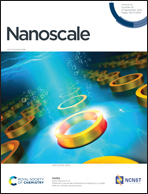Combined spin filtering actions in hybrid magnetic junctions based on organic chains covalently attached to graphene†
Abstract
We present a bias-controlled spin-filtering mechanism in spin-valves including a hybrid organic chain/graphene interface. Wet growth conditions of oligomeric molecular chains would usually lead, during standard CMOS-compatible fabrication processes, to the quenching of spintronics properties of metallic spin sources due to oxidation. We demonstrate by X-ray photoelectron spectroscopy that the use of a protective graphene layer fully preserves the metallic character of the ferromagnetic surface and thus its capability to deliver spin polarized currents. We focus here on a small aromatic chain of controllable lengths, formed by nitrobenzene monomers and derived from the commercial 4-nitrobenzene diazonium tetrafluoroborate, covalently attached to the graphene passivated spin sources thanks to electroreduction. A unique bias dependent switch of the spin signal is then observed in complete spin valve devices, from minority to majority spin carriers filtering. First-principles calculations are used to highlight the key role played by the spin-dependent hybridization of electronic states present at the different interfaces. Our work is a first step towards the exploration of spin transport using different functional molecular chains. It opens the perspective of atomic tailoring of magnetic junction devices towards spin and quantum transport control, thanks to the flexibility of ambient electrochemical surface functionalization processes.



 Please wait while we load your content...
Please wait while we load your content...